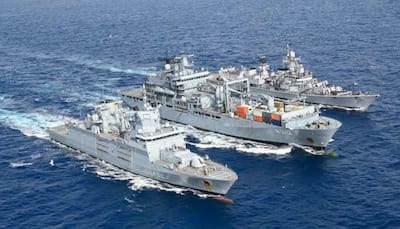As the geopolitical tides shift in the Indian Ocean Region (IOR), the Indian Navy has emerged as a linchpin of stability, safeguarding critical trade routes, countering piracy, and fostering regional security. Responsible for policing a maritime corridor that carries over 80% of global seaborne trade, the Navy’s evolving role reflects India’s aspirations as a maritime power and its pivotal contribution to global commerce and energy security.
From its traditional focus on coastal defence to its expanded mandate as a “net security provider,” the Indian Navy’s transformation is emblematic of India’s ascent as a maritime power in a multipolar world. This article explores how the Indian Navy navigates complex challenges in the region, leveraging its capabilities to maintain order in one of the world’s busiest waterways.
Historically, India’s naval priorities were focused on coastal defence, primarily land-based threats. However, the 2008 Mumbai terror attacks, orchestrated by seaborne militants, exposed vulnerabilities in the maritime domain, compelling India to rethink its naval strategy.
The watershed moment came in 2015 with the release of Ensuring Secure Seas: Indian Maritime Security Strategy. The document articulated a bold vision: India would act as the IOR’s “net security provider,” expanding its naval footprint from the Straits of Malacca to the Persian Gulf and beyond. This shift aligned with India’s strategic interests in securing the sea lanes of communication (SLOCs), which are vital for its energy imports and burgeoning trade.
The Navy’s transformation has been bolstered by modernisation efforts, including the induction of advanced warships, submarines, and surveillance systems. Integrating indigenous shipbuilding into the fleet’s development also underscores India’s ambitions for self-reliance while enhancing its blue-water capabilities.
The Indian Navy’s operational achievements exemplify its strategic vision and technical prowess. In 2024 alone, a series of high-stakes missions underscored its commitment to regional stability:
– Operation MV Leela Norfolk: In January, the Navy’s elite MARCOS (Marine Commandos) neutralised a hijacking in the North Arabian Sea. The mission, executed with precision, ensured the safe return of crew and cargo.
– Operation MV Genco Picardy: Responding to a distress call in the Gulf of Aden, the Navy thwarted a drone attack on the vessel, demonstrating its readiness to counter asymmetrical threats.
– Operation Iman and Lorenzo Pua 04: Off Somalia’s coast, the Navy secured two hijacked vessels, freeing their crew and affirming its anti-piracy credentials.
Such missions highlight the Navy’s agility, operational expertise, and role as a dependable partner for nations reliant on secure Indian Ocean routes.
Central to the Navy’s operational success is its Marine Commandos, or MARCOS. Trained to operate in high-risk environments, these commandos are equipped for amphibious raids, counter-terrorism missions, and intelligence operations. Often compared to Britain’s Special Boat Service (SBS) and the US Navy SEALs, MARCOS personnel undergo gruelling training, with only a fraction making the cut. Their capability was evident during Operation MV Leela Norfolk, where their rapid response neutralised the hijackers, preventing a potential crisis.
The Gulf of Aden, a gateway for global energy shipments, remains a focal point of the Navy’s maritime strategy. With piracy resurging in these waters, the Indian Navy has maintained a robust presence, deploying a rotating fleet of warships and patrol vessels.
These deployments are not just about counter-piracy; they represent India’s broader strategic intent to assert influence in key chokepoints and contested waterways. The Navy reinforces its commitment to maintaining stability in a region critical to global trade by ensuring secure passage through the Gulf and Western Arabian Sea.
India’s maritime efforts have not gone unnoticed. The Navy’s proactive role in the IOR has drawn praise from international partners, including the United States, which views India as a regional stabilising force.
China, on the other hand, remains wary of India’s expanding naval footprint. The Indian Navy’s presence counterbalances Beijing’s growing influence in the Indian Ocean, particularly as China seeks to extend its Belt and Road Initiative through maritime investments.
India’s partnerships extend beyond geopolitics; joint exercises with allies such as France, Japan, and Australia demonstrate the Navy’s emphasis on interoperability and collective security. Initiatives like the Information Fusion Centre-Indian Ocean Region (IFC-IOR) also facilitate real-time data sharing, enhancing India’s maritime domain awareness.
Looking ahead, the Indian Navy envisions a formidable expansion of its capabilities. The induction of additional aircraft carriers, enhanced submarine fleets, and advanced surveillance systems are on the horizon.
This modernisation aligns with India’s dual objectives: ensuring self-reliance through indigenous defence production and fostering strategic partnerships to address emerging challenges. Projects like the INS Vikrant, India’s indigenously built aircraft carrier, signify a leap forward in achieving these goals.
India’s commitment to maritime security also extends to its environmental and humanitarian efforts. The Navy plays a crucial role in disaster relief, search-and-rescue missions, and combating illegal fishing, showcasing its multifaceted utility in the region.
The Indian Navy’s evolution from a coastal defence force to a regional security provider reflects India’s strategic ambitions in the Indian Ocean. By securing vital trade routes, countering piracy, and responding to emerging threats, the Navy protects India’s interests and contributes to the global common good.
As the IOR becomes an increasingly contested arena, the Navy’s role in shaping a stable maritime order will remain indispensable. The seas are more than a strategic frontier for India—they are a vital artery of its economic and geopolitical future. Through its proactive and adaptive approach, the Indian Navy anchors itself as a guarantor of security in one of the world’s most critical regions.
Written By: Ashish Singh, Defence Expert
Stay informed on all the , real-time updates, and follow all the important headlines in and on Zee News.






